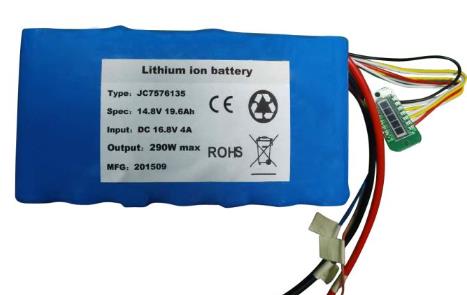As LCD display in YFJ company that we usually use it to military grade battery ,especially Lithium-ion batteries ,for these battery applications ,we have obvious advantage is that we focus more on shor circuit protection which we follow the US military standard.
Short circuit protection:The following test shall be performed. Charge batteriesas specified in ; use of 4.6.3 is permitted. Measure and record the OCV. Short each battery across all the positive and negative terminals with a total external resistance not greater than 50 milliohms. After one hour remove the short from across the terminals. Measure and record the OCV. Stabilize batteries at the normal conditions of 4.3.1 for not less than 2 hours. Chargebatteries in accordance with 4.6; use of 4.6.3 is permitted. Stabilize batteries at normal conditions for not less than 2 hours, then discharge the battery in accordance with 4.7.2.3. The battery shall meet the requirements of 3.7.2.3.
Li-Ion Battery With Lcd Display
Charge voltage: 16.8V
Nominal voltage : 14.8V
(4S7P)
Initial impedance : 120mΩ
Nominal capacity: 19.6Ah
Minimum capacity: 19.4Ah
Communication methods : SMBUS data communication
Electricity quantity show: LCD Electricity quantity show
Charge current: Standard Charging::0.2C5A (3.9A)
Rapid charge: 0.5C5A C(9.8A) Max
Standard Charging method : 3.9A(0.2C5A) CC(constant current)charge
to 16.8V,then CV(constant voltage 16.8V)charge till charge current decline to
≤196mA(≈0.01C5A)
Charging
time:Standard Charging: 6.5hours(Ref.)
Rapid charge: 3.5 hours(Ref.)
Max.discharge current: 9.8A(0.5C5A)
Discharge cut-off voltage: 10.0V
Cycle life (0.2C5A/0.2C5A) : 500 items,≧80%DOD;
300 times,≧80%DOD
Operating
temperature : Charging: 0℃~45℃
Discharging:-20℃~+60℃
Li-ion Battery With LCD Display Li-Ion Battery With Lcd Display,Battery Charger With Lcd Display,Battery Pack With Lcd Display,Rechargeable Battery Pack With Lcd Display YFJ TECHNOLOGY (HK) CO.,LIMITED , http://www.yfjpower.com
Panasonic said that as of the end of July, the company's LED bulb products totaled 48 models, while the incandescent bulb products have dropped from the 207 in 2008 to the current four. Panasonic's competitors in the lighting market, Toshiba and Mitsubishi Electric, have also stopped producing incandescent bulbs.
Since the production of incandescent bulbs in 1936, Panasonic's production of incandescent bulbs has reached 3.3 billion. In Japan's overall power demand, lighting accounts for 20% of the total, so if the lighting products are converted into LED bulbs or energy-efficient fluorescent lamps, the power demand can be greatly reduced. At present, in Japan's overall lighting market, the proportion of products with low energy efficiency is still as high as 60%. 

On July 12, Panasonic announced that the lineup of energy-saving products such as LED bulbs used to replace incandescent bulbs has become more complete, and the Japanese government proposed to manufacturers and retailers to accelerate the popularization of LED bulbs in June. The resolution was discontinued on October 31, 2012 for the white light bulb products used in general households. The production stoppage time will be half a year earlier than the originally planned March 31, 2013.